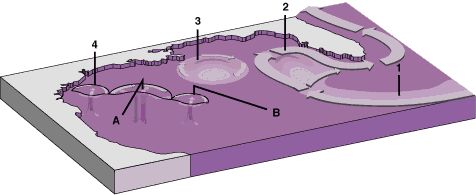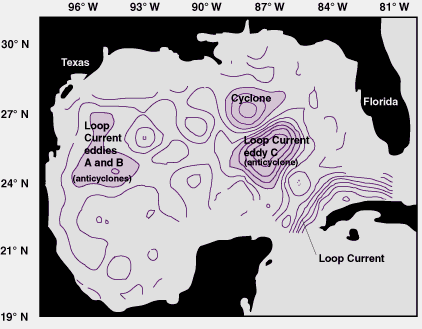

1. Warm water from the Caribbean Sea enters the gulf.
2. A "Loop Current" gradually forms in the eastern gulf. Eventually, the loop breaks off and forms an eddy.
3. The eddy has a core of warm water, and rotates clockwise as it moves west across the gulf. Clockwise-rotating eddies in the northern hemisphere are called anticyclones.
4. Smaller eddies spin off the warm anticyclones. These rotate in the opposite direction, and are called cyclones.
A. In an anticyclone, warm water converges in the eddy center and is pushed toward the seaþoor. Anticyclones contain few nutrients to support plant and animal life. They can be thought of as "ocean deserts."
B. Cyclones draw cold, nutrient-rich water from the deep gulf up toward the surface. Near the surface the combination of sunlight and plenty of nutrients creates an "ocean oasis," with abundant plankton for marine animals to eat.

A contour map of the gulf depicts the variations in sea-surface height caused by Loop Current eddies. This map shows the Loop Current soon after it shed Eddy C in mid-September 1996. Dark purple areas indicate anticyclonic Loop Current eddies A, B, and C moving through the gulf. (Data courtesy of George Born and Robert Leben, Colorado Center for Astrodynamics Research).
George Born and Robert Leben of the University of Colorado used data from satellites TOPEX/POSEIDON and ERS-2 to track the location of the Loop Current, and to monitor the anticyclonic eddies that periodically separate from its northward intrusions into the eastern Gulf of Mexico.
The Loop Current shed a series of three such anticyclonic eddies in 1996, but throughout the year a broad area of cyclonic, lower than average sea-surface height remained in the northeast corner of the gulf.
In mid-September 1996, the cyclone was 20 or more centimeters lower in sea-surface height than the surrounding continental margin, and more than half a meter lower than the Loop Current and the three anticyclonic eddies (A, B, and C) that it shed in 1996.